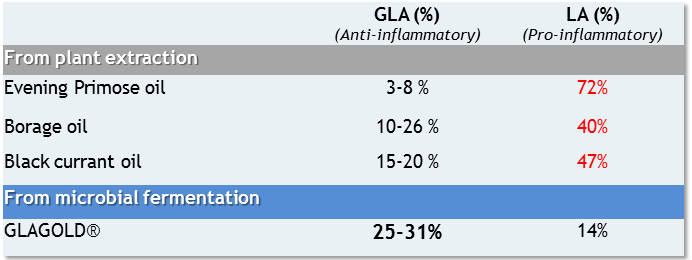GLA
Gamma-linolenic acid (GLA) is an omega-6 polyunsaturated fatty acid (EFA). It is almost completely and very rapidly converted to dihomo-gamma-linolenic acid (DGLA), which undergoes further metabolism to produce anti-inflammatory eicosanoids (series-1 prostanglandins and series-3 leukotrienes).
Why do we need oral supplement of GLA if LA is converted to GLA inside the body?
It is true that the body should convert some LA to GLA, and in turn to produce beneficial eicosanoids. However, not everyone can efficiently convert LA to GLA.
Many people have difficulty converting LA to GLA due to an impairment in a critical enzyme known as Delta-6-Desaturase (D6D), which is associated with:
Studies have shown that GLA has significant health benefits when consumed regularly. GLA plays a beneficial role in areas such as
- Inflammation
- Critical diseases
- Women's health (PMS, Menopause, Osteoporosis)
- Joint Health
- Skin Inflammation (Allergy, Pruritus, Redness)
- Haemodialysis
- Complications caused by high blood sugar
- Cardiovascular health (improves both macro- & micro-circulation)
We may get GLA from 3 ways:
1. Conversion from LA to GLA inside our bodies.
2. Breast milk
3. Health supplements, such as evening primose oil, borage oil, black currant oil and the latest one that is extracted from microbial fermentation.
|
How does GLA work? GLA improves microcirculation in the following ways:
|
 |
Why do we need oral supplement of GLA if LA is converted to GLA inside the body?
It is true that the body should convert some LA to GLA, and in turn to produce beneficial eicosanoids. However, not everyone can efficiently convert LA to GLA.
Many people have difficulty converting LA to GLA due to an impairment in a critical enzyme known as Delta-6-Desaturase (D6D), which is associated with:
- Diabetes
- Ageing
- Excessive consumption of alcohol
- Vitamin deficiencies
- Stress, lack of sleep
- Malnutrition
- Medication, preservatives
- Diseases like dermatitis, premenstrual syndrome, rheumatoid arthritis, cancer and cardiovascular disease
Supplementation with GLA may therefore be an option for those who are not efficient at conversion.
Concentration of different sources of GLA1

Reference
1. D. Edward Barre, Potential of evening primose, borage, black currant, and fungal oils in human health, Ann Nutr Metab 2001; 45:47-57.

